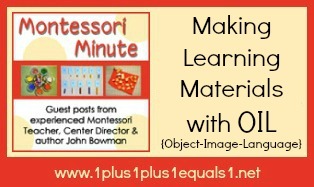{disclosure: this post contains affiliate links}
This is a guest post written by John Bowman, author of Montessori at Home!
For this Montessori Minute, I’ve included an excerpt from the just-released Third edition of Montessori At Home! This is from one of the first how-to chapters, titled: A Parent’s Guide to Using Learning Materials at Home.
Make materials with OIL
I don’t mean that you should sprinkle cooking oil on your child’s learning materials! In this case, OIL stands for:
- Left: A child’s first experiences with fractions often involve cutting Objects like fruit.
- Middle: An apple fractions Image from A Child’s Place.
- Right: Language and numerical symbols that identify and describe the objects and the graphic image.
Far left: Montessori Geometric Solids are the objects. The Geometric Solids Three Part Cards from Montessori Print Shop provide the graphic images and language in one material.
If your child is 2-3 years old, she may not show as much interest in the images and words, and that’s fine. Just exposing him to them will be enough. As your child gets older and uses learning materials more, you will see her start working with the images and words more and more. Soon, he will be in his sensitive period for reading, writing, and math. Including these elements in your learning materials will make them even more effective tools for helping your child build the best brain architecture possible.
Many quotes from Maria Montessori are included throughout the third Edition. Here are a couple relating to learning materials and how they are presented in Montessori:
" Besides the various objects which the children are taught to use for their ‘practical life’, there are many others which lend themselves to the gradual development and refinement of a child’s intellect. There are, for example, various materials for the education of the senses, for learning the alphabet, numbers, reading, writing, and arithmetic…..When we speak of ‘environment’ we include the sum total of objects which a child can freely choose and use as he pleases, that is to say, according to his needs and tendencies. A teacher simply assists him at the beginning to get his bearings among so many different things and teaches him the precise use of each of them, that is to say, she introduces him to the ordered and active life of the environment."
Maria Montessori, The Discovery of the Child
When a parent acts as a child’s teacher, she does the same thing – create an environment rich in opportunities for meaningful, interesting activity and introduce the child to the materials it contains. She helps sparingly, only as needed, and introduces new materials when the child is ready and interested, always following the child and the Inner Teacher.
" The battle is finally won when the child finds something, some particular object, that spontaneously arouses his intense interest. Sometimes this enthusiasm comes suddenly and without warning. As soon as children find something that interests them they lose their instability and learn to concentrate….Children of a nervous temperament have become calm, the depressed have regained their spirits, and all have advanced together along the path of disciplined work, making progress through the outward manifestation of an inner energy which has found a means of expression. These fixed attainments have an explosive character that foretells a child’s later development. They may be compared to the sprouting of a child’s first tooth or his first steps."
Maria Montessori, The Secret of Childhood
The new Third Edition of Montessori At Home!, is a totally updated, 512 page pdf eBook guide to doing Montessori early learning activities at home.
© 2013 John Bowman
My thanks to John for writing this extensive article for us here at 1+1+1=1! I invite you to ask him any questions you may have in the comments below and he can hopefully answer them for you. If you have an article you hope he will write for us in the future, please let us know in the comments also! Be sure to let him know if this article was helpful-we all love encouragement, right?
Did you miss earlier Montessori Minute Posts?
- Introducing Montessori Minute
- Where Do I Start?
- Sensory Activities
- Understanding Dr. Maria Montessori
- A Preschoolers Guide to Home Improvement
- The Three Part Lesson
- What is Montessori?
- Developing a Positive Self Image
- Concentration & Normalization
- Toys vs. Learning Materials
- Q & A with John Bowman {answers to questions left on the Sensory Activities post}





